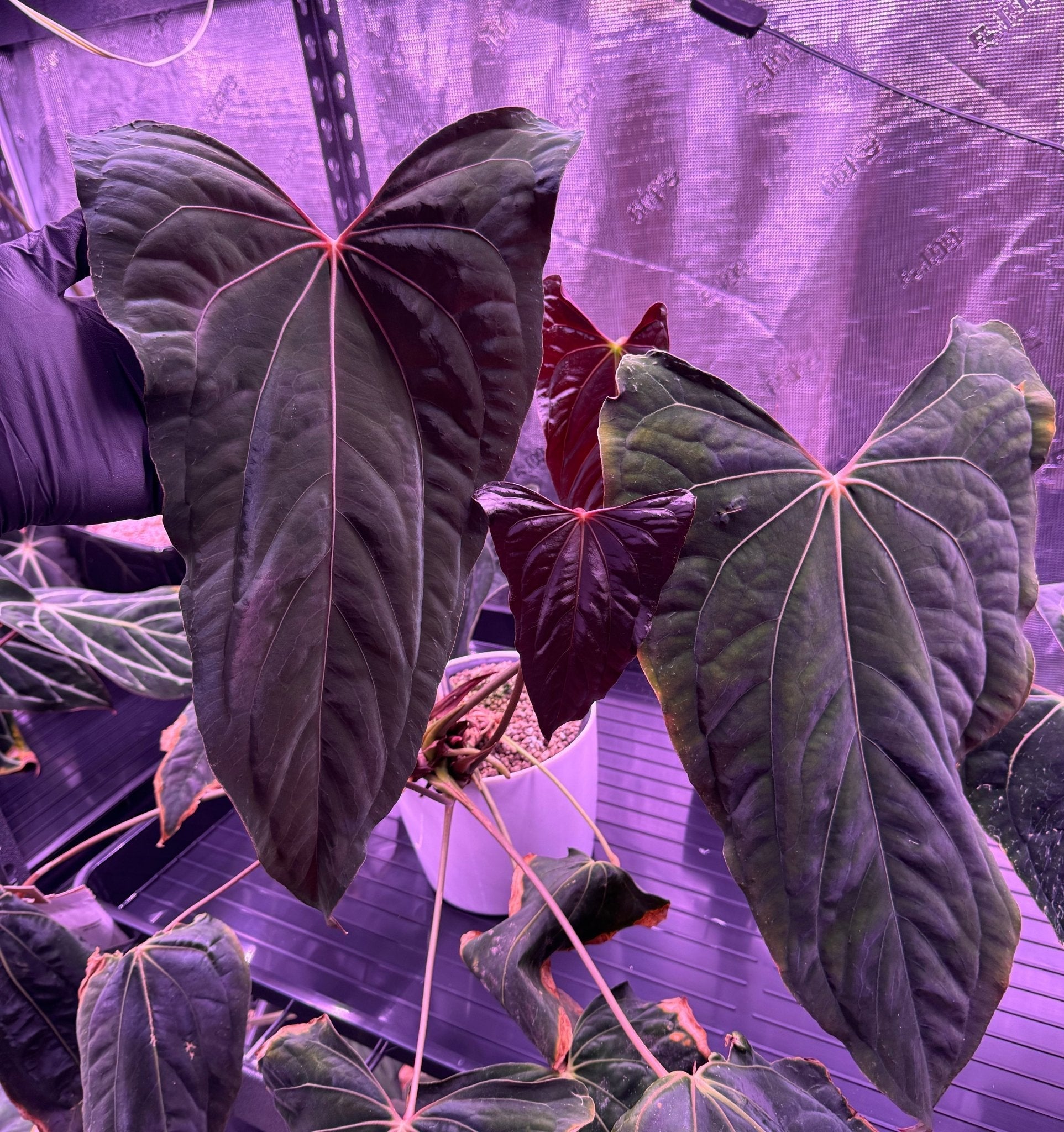About
Anthurium papillilaminum is a beautiful dark velvet leafed Anthurium from lowland Panama. The best examples possess inky dark leaves and deep red/violet abaxials. Petioles are terete (rounded) to subterete (slightly less than round (some paps can have a shallow groove/sulcus along the dorsal petiole)). Spathe color is green with varying degrees of red/violet tinge.
Historically there have been two main “types” of papillilaminum; Lago Gatun (LG) and Canal. Recently there have been a number of new localities introduced through poaching which I will touch on briefly below but which are hard to categorize due to the nature in which they were collected and the lack of credibility of the stated origins.
Lago Gatun is the type locality and therefore these are the OG or most classical example of paps. The best examples tend to have dark green leaves with a bullate texture. In comparison to Canal paps they tend to have taller more rounded lobes and a narrower sinus although there is some overlap between both types in lobe/sinus shape due to variation. They have reddish abaxial leaves though not typically reaching the level of deep red/violet as a Canal pap. Examples of LG paps would include the RA pap clones as well as a number of Paul Marcellini’s named pap clones and Jay Vannini’s Green Genie clone.
Canal pap is a term used to refer to two particularly unique wild collected specimens Fort Sherman (FS) and Ralph Lynam (RL) and their derivative crosses (FSRL, RLFS, FS self, RL self etc) which were grown and bred originally by Jay Vannini. The name “canal” I believe was introduced by Jay Vannini referring to the proximity of the collection sites to the Panama Canal. These plants tend to have more elongated narrower leaf shapes with a wider sinus, shorter, pointed lobes and an overall more triangular shape in comparison to the LG ecotype. Nice, well grown plants also tend to have varying degrees of red and yellow on the emergent veins and deep red/violet leaf abaxials. They also seem to achieve a different level of inky dark color and oil slick than the LG plants. A number of other paps clones of uncertain origin such as the Ree Gardens pap and Vanderbilt pap share characteristics with the canal paps and may be of similar origin.
Other locales
More recently there have been numerous new locales or “types” of paps introduced into circulation following extensive poaching activity throughout Panama. The main names these are traded under are Guna Yala (GY) and Cocle, however a continuous stream of new names and locations are introduced almost daily it seems. Due to the lack of reliable collection data it is impossible to determine the actual origin or even identity of many of these plants some of which could even be distinct species, subspecies or wild hybrids. It also appears a number of these plants were sold misidentified/mislabeled as BVEP although one look at their vibrant red abaxials disproves this. Finally, due to the desire to recoup investments a number of these plants are likely being bred with and sold under false identification which is unfortunate for collectors to whom tracking lineage is important.
Care/Growing Conditions
Anthurium papillilaminum is one of the more easy going of the rare velvet anthuriums in my experience and don’t require any specialized considerations beyond your average anthurium. Though they prefer similar tent/greenhouse conditions as the other slightly more fussy velvet species (ie dressleri, carla and antolakii), they can be acclimated to reasonable ambient conditions much more readily than these other species in my experience. They will look their best in low light conditions but are not as sensitive to slightly higher light levels as some of their cousins such as dressleri/kuna.
This is a fast growing species that has a bit of a leggier growth habit and larger intermodal spacing than the other dark velvets its typically grouped with. It also has a tendency to make very significant changes in both size and leaf morphology well beyond the point of reaching cataphyll growth with petioles becoming much thicker and longer and leaves tending to broaden significantly (even so called “dagger” individuals).
What I’m looking for in a great pap
I personally prefer the Canal paps for breeding and hybridization purposes in most scenarios (although i do think there are some cases where a good LG pap clone would make more sense), so I will focus on the canal paps.
The most obvious traits that make a great canal pap are inky dark color, narrower/elongated shape and a wider or flatter sinus. Additional details that are extremely important to me would be significant red on the emergent veins that persists at least to some degree after hardening and very deep red/violet abaxial leaf color persisting on multiple subsequent leaves. A more compact growth habit is also a plus although this may be wishful thinking.

A select hold back from a cross between my FSRL and my FS self that exhibits most of the traits I am looking for in a Canal pap including nicely contrasting red veins that persist beyond hardening and an elongated leaf form with wide sinus.




